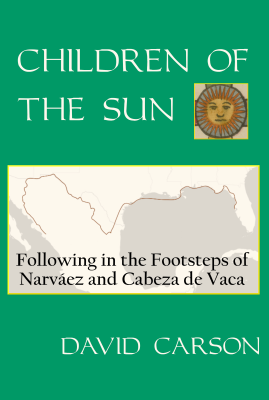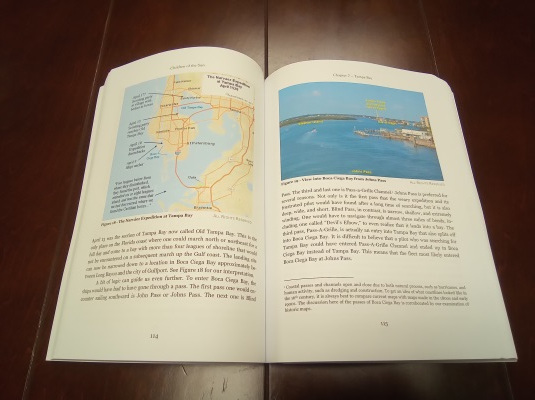
Children of the Sun
Children of the Sun: Following in the Footsteps of Narvaez and Cabeza de Vaca is David Carson's interpretation of the route of the Narváez Expedition and its four survivors, which included Álvar Núñez Cabeza de Vaca, the first Texas historian.
 E-book format Color Read it in:
$16.99 at Apple, Kobo, Angus & Robertson, Thalia, !ndigo, Vivlio $22.99 at Amazon |
 Paperback format 505 pages, color Price: $45.99 at Amazon $55.00 at AbeBooks - signed by author |
Book Description
In 1528, Pánfilo de Narváez, a smart and courageous - but reckless - Spanish conquistador, landed near Tampa Bay and took 300 of his men on a quest to find gold. They disappeared. Eight years later, three Spaniards and one African appeared 1,500 miles away at a remote slaving camp on Mexico's Pacific coast, at the head of a throng of hundreds of native Americans. These four strange men claimed they were members of the long-lost Narváez Expedition. The natives following them claimed they were something else: Children of the Sun.
The stories these four ragged castaways told comprise some of the earliest history of the United States. Ever since they were translated to English in the late 1800s, U.S. historians, both professional and amateur, have been trying to understand their route. In Children of the Sun, Texas historian David Carson undertakes the most detailed, careful, comprehensive effort yet to plot every segment of their 1,500-mile, 8-year journey from Pinellas County, Florida to Culiacan, Sinaloa. What makes Carson's analysis different from those preceding it is his extensive fieldwork. This book was not written by someone sitting at a desk with a mapping program; it was done by retracing the explorers' steps as much as possible, by driving and walking along the same paths they went on, and even foraging the same palmettos, dewberries, and prickly pear fruit they ate. Through his first-hand descriptions of the country, dozens of handheld and aerial drone color photographs, custom maps, and driving directions, Carson takes his readers on a guided tour, giving them an experience no other book on the Narváez Expedition has ever provided.
In addition to their notes about flora, fauna, and terrain, the two preserved accounts that the expedition survivors wrote, especially the one authored by Alvar Nunez Cabeza de Vaca, also contain a wealth of information about the natives they traded with, fought with, were enslaved by, and were worshipped by. From the Tocobaga, Timucua, and Apalachee of Florida to the Karankawa of Texas, the Coahuiltecans and Otomoacos of the Rio Grande, and the Chichimecas of northern Mexico, Cabeza de Vaca provides fascinating details about the natives' habits and traditions before the arrival of Europeans, such as their "black drink" ritual, their widespread use of ceremonial healing, and their custom of escorting travelers. Readers will see how some of these beliefs, combined with the Europeans' strange appearance and their arrival from the east, resulted in the natives' holding them up to be "children of the sun" possessing supernatural powers.
All great historical sagas take place within a context. Narváez's landing in Florida was the culmination of events that began with Columbus's discovery of the New World and were accelerated by Ponce de Leon's discovery of Florida and Hernan Cortes's conquest of Mexico. Children of the Sun brings readers up to speed on all of these events, so that they may fully understand what motivated Narváez, Cabeza de Vaca, and their comrades. Like his route analysis, David Carson's historical interpretations are well-researched, placing a premium on accuracy, instead of misleading the reader with popular theories and entertaining legends that fail to withstand careful scrutiny.